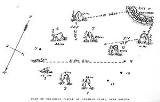
Cheetham Close
Encyclopedia
Cheetham Close is a megalith
and scheduled ancient monument located in Lancashire
, very close to the boundary with Greater Manchester
, England. The megalith was in good condition until a farmer from Turton sledgehammered the circle in the 1870s. According to an article published in 1829, Cheetham Close was once a druid
ical ritual place and a Roman road
passed 'within two hundred yards' of the megalith.
The stone circle at Cheetham Close measured about 18.5 metres (60.7 ft) in diameter. Six stones are definitely part of the circle and other smaller stones are scattered about the place. The monument has been damaged, and the stones fractured.
 The area was surveyed by Dryden in 1850 who identified a circle of six stones. In 1871 Greenhalgh identified a seventh stone and drew attention to the destruction of the site. In 1894 French discovered a second site which was a "ring bank" type cairn
The area was surveyed by Dryden in 1850 who identified a circle of six stones. In 1871 Greenhalgh identified a seventh stone and drew attention to the destruction of the site. In 1894 French discovered a second site which was a "ring bank" type cairn
. A saddle quern
was found in 1954 and the site was scheduled in 1958. Three barb
ed and tanged arrowhead
s were found at a third site in 1959.
In 1983 a large scale survey was undertaken by the Bury Archaeological Group and M. Fletcher. The stone circle was in a severely damaged state with only two of the seven megaliths still in situ. The site probably origimally contained ten equally spaced gritstone slabs.
The ring cairn lies to the south of the stone circle. Fletcher suggests that Cheetham Close dates from an early period between 2100 and 1500BC in the Early Bronze Age
. The quern and arrowheads suggest the settlers were a pastoral community who supplemented their diet by hunting.
Megalith
A megalith is a large stone that has been used to construct a structure or monument, either alone or together with other stones. Megalithic describes structures made of such large stones, utilizing an interlocking system without the use of mortar or cement.The word 'megalith' comes from the Ancient...
and scheduled ancient monument located in Lancashire
Lancashire
Lancashire is a non-metropolitan county of historic origin in the North West of England. It takes its name from the city of Lancaster, and is sometimes known as the County of Lancaster. Although Lancaster is still considered to be the county town, Lancashire County Council is based in Preston...
, very close to the boundary with Greater Manchester
Greater Manchester
Greater Manchester is a metropolitan county in North West England, with a population of 2.6 million. It encompasses one of the largest metropolitan areas in the United Kingdom and comprises ten metropolitan boroughs: Bolton, Bury, Oldham, Rochdale, Stockport, Tameside, Trafford, Wigan, and the...
, England. The megalith was in good condition until a farmer from Turton sledgehammered the circle in the 1870s. According to an article published in 1829, Cheetham Close was once a druid
Druid
A druid was a member of the priestly class in Britain, Ireland, and Gaul, and possibly other parts of Celtic western Europe, during the Iron Age....
ical ritual place and a Roman road
Roman road
The Roman roads were a vital part of the development of the Roman state, from about 500 BC through the expansion during the Roman Republic and the Roman Empire. Roman roads enabled the Romans to move armies and trade goods and to communicate. The Roman road system spanned more than 400,000 km...
passed 'within two hundred yards' of the megalith.
The stone circle at Cheetham Close measured about 18.5 metres (60.7 ft) in diameter. Six stones are definitely part of the circle and other smaller stones are scattered about the place. The monument has been damaged, and the stones fractured.
Archaeological surveys

Cairn
Cairn is a term used mainly in the English-speaking world for a man-made pile of stones. It comes from the or . Cairns are found all over the world in uplands, on moorland, on mountaintops, near waterways and on sea cliffs, and also in barren desert and tundra areas...
. A saddle quern
Quern-stone
Quern-stones are stone tools for hand grinding a wide variety of materials. They were used in pairs. The lower, stationary, stone is called a quern, whilst the upper, mobile, stone is called a handstone...
was found in 1954 and the site was scheduled in 1958. Three barb
Barb
Barb may refer to:* A backward-facing point on a fish hook or similar implement, rendering extraction from the victim's flesh more difficult* Wind barbs for each station on a map of reported weather conditions...
ed and tanged arrowhead
Arrowhead
An arrowhead is a tip, usually sharpened, added to an arrow to make it more deadly or to fulfill some special purpose. Historically arrowheads were made of stone and of organic materials; as human civilization progressed other materials were used...
s were found at a third site in 1959.
In 1983 a large scale survey was undertaken by the Bury Archaeological Group and M. Fletcher. The stone circle was in a severely damaged state with only two of the seven megaliths still in situ. The site probably origimally contained ten equally spaced gritstone slabs.
The ring cairn lies to the south of the stone circle. Fletcher suggests that Cheetham Close dates from an early period between 2100 and 1500BC in the Early Bronze Age
Bronze Age
The Bronze Age is a period characterized by the use of copper and its alloy bronze as the chief hard materials in the manufacture of some implements and weapons. Chronologically, it stands between the Stone Age and Iron Age...
. The quern and arrowheads suggest the settlers were a pastoral community who supplemented their diet by hunting.

